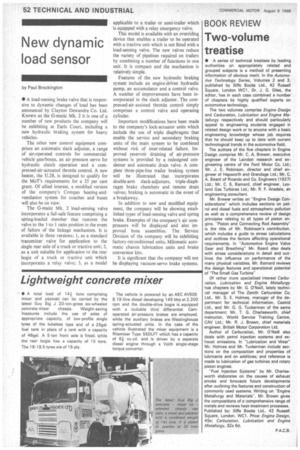BOOK REVIEW
Page 54

If you've noticed an error in this article please click here to report it so we can fix it.
Two-volume treatise
• A series of technical treatises by leading authorities on appropriately related and grouped subjects is a method of presenting information of obvious merit. In the Automotive Technology Series, Volumes 2 and 3, published by Iliffe Books Ltd., 42 Russell Square, London WC1, Dr. J. G, Giles, the editor, has in each case combined a number of chapters by highly qualified experts on automotive technology.
The two volumes comprise Engine Design and Carburation, Lubrication and Engine Metallurgy respectively and should particularly appeal to engineering students engaged in related design work or to anyone with a basic engineering knowledge whose job requires that he should keep up to date with current technological trends in the automotive field.
The authors of the five chapters in Engine Design comprise Mr. C. A. Brewer, executive engineer of the Laindon research and engineering centre of the Ford Motor Co. Ltd.; Mr. J. E. Robinson, director and chief engineer of Hepworth and Grandage Ltd.; Mr. C. A, Beard of Ricardo and Co. Engineers (1927) Ltd.; Mr. C. S. Barnard, chief engineer, Leyland Gas Turbines Ltd.; Mr. R. F. Ansdale, an engineering consultant.
Mr. Brewer writes on "Engine Design Considerations" which includes sections on petrol and diesel fuels and atmospheric pollution as well as a comprehensive review of design principles relating to all types of piston engine. "Piston and Connecting Rod Assembly" is the title of Mr. Robinson's contribution, which includes a guide to stress calculations and outlines the factors affecting operational requirements. In "Automotive Engine Valve Gear and Breathing" Mr. Beard also deals with stress considerations in detail and outlines the influence on performance of the many physical variables. Mr. Barnard reviews the design features and operational potential of "The Small Gas Turbine"
Of rather more specialized interest Carburation, Lubrication and Engine Metallurgy has chapters by Mr. G. O'Neill, lately technical manager of The Zenith Carburetter Co. Ltd., Mr. S. E. Holmes, manager of the department for technical information, Castro) Ltd., and Mr. G. G. Tuckerman of the same department; Mr. T. G. Charlesworth, chief instructor, World Service Training Centre, CAV Ltd.; Mr. R. J. Brown, chief materials engineer, British Motor Corporation Ltd.
Author of Carburation, Mr. O'Neill also deals with petrol injection systems and exhaust emissions. In "Lubrication and Wear" Mr. Holmes and Mr. Tuckerman include sections on the composition and properties of lubricants and on additives; and reference is made to lubrication of gas turbines and rotary piston engines.
"Fuel Injection Systems" by Mr. Charlesworth elaborates on the causes of exhaust smoke and forecasts future developments after outlining the features and construction of commonly used systems. Writing on "Engine Metallurgy and Materials", Mr. Brown gives the compositions of a comprehensive range of metals and reviews heat-treatment processes. Published by: Iliffe Books Ltd., 42 Russell Square, London, WC1. Price: Engine Design, 45s; Carburation, Lubrication and Engine Metallurgy, 32s 6d.
















































































































































